 Weird Stuff
Weird Stuff  Weird Stuff
Weird Stuff  Mysteries
Mysteries 10 Tragic Disappearances and Deaths in Joshua Tree National Park
 History
History 10 Ways Childhood Really Sucked in the Old West
 Music
Music 10 Name Origins of Famous Bands from the 1990s
 Religion
Religion 10 Biggest Turnarounds by the Catholic Church
 Weird Stuff
Weird Stuff 10 Unbelievable Times Laws Had Unintended Consequences
 Humans
Humans Ten Historic Women Who Deserve Way More Credit Than They Got
 Movies and TV
Movies and TV 10 Films That Spawned Major Lawsuits
 History
History Ten Times Towns Were Wiped Off the Face of the Earth
 Creepy
Creepy 10 of the Most Disturbingly Haunted Public Houses in the UK
 Weird Stuff
Weird Stuff 10 Niche Subcultures That Are More Popular Than You Might Think
 Mysteries
Mysteries 10 Tragic Disappearances and Deaths in Joshua Tree National Park
 History
History 10 Ways Childhood Really Sucked in the Old West
Who's Behind Listverse?

Jamie Frater
Head Editor
Jamie founded Listverse due to an insatiable desire to share fascinating, obscure, and bizarre facts. He has been a guest speaker on numerous national radio and television stations and is a five time published author.
More About Us Music
Music 10 Name Origins of Famous Bands from the 1990s
 Religion
Religion 10 Biggest Turnarounds by the Catholic Church
 Weird Stuff
Weird Stuff 10 Unbelievable Times Laws Had Unintended Consequences
 Humans
Humans Ten Historic Women Who Deserve Way More Credit Than They Got
 Movies and TV
Movies and TV 10 Films That Spawned Major Lawsuits
 History
History Ten Times Towns Were Wiped Off the Face of the Earth
 Creepy
Creepy 10 of the Most Disturbingly Haunted Public Houses in the UK
10 People Who Have Lived In A Tree
For many adults, the adventure and excitement of playing in the treetops is a romantic notion of childhood. People remember climbing trees and building secret tree forts high up in the branches during their youth, but only a special few live this reality into adulthood.
The motives for living in a tree may vary, but it’s scientific fact that trees provide incredible health benefits. Trees not only give us the essential oxygen we need to breathe, but recent studies show that they actively remove deadly pollution from the air.
Also, being in a natural environment surrounded by trees improves psychological well-being. It makes people feel less rage, exhaustion, and depression. In Japan, they even have a word for this: shinrin-yoku (“forest bathing”). It’s the practice of being in nature to restore energy and improve one’s mood.
It’s not always fairy-tale castles in the sky, however. A lucky few build luxury tree houses to be sure, but others live in trees because of desperation, tradition, or a sacrifice to further a valiant cause.
10 Activist Julia Butterfly Hill
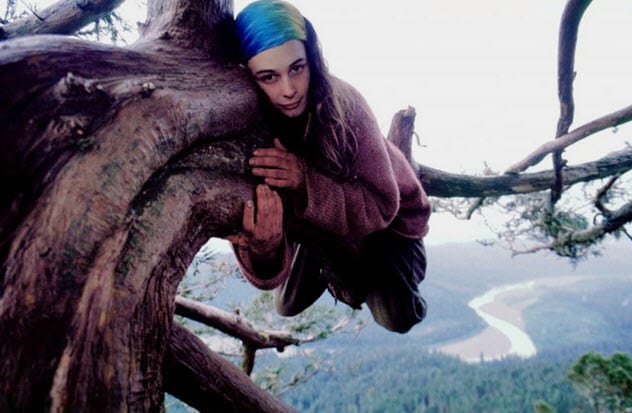
In 1997, Julia Butterfly Hill climbed to the top of a 1,000-year-old redwood tree that was 55 meters tall (180 ft). She climbed that treacherous height to tree-sit for one week to protest the clear-cutting of an ancient redwood forest.
It ended up being 738 days before she touched ground again. She remained in that tree despite terrifying storms and constant harassment from helicopters, loggers, and security guards sent by the Pacific Lumber Company.
For two years, she watched in horror as the forest surrounding her treetop dwelling was destroyed. Clear-cutting is the fastest and cheapest way to harvest timber. Once a tree is chopped down, the area is burned with napalm and sprayed with herbicides. Afterward, the tree is replanted, but environmental scientists agree that this practice permanently damages the area.
Hill said, “It’s like sitting there and watching your family killed. You listen for hours . . . a high-pitched screaming that goes right through your body. And when they stop the chainsaws and pound the wedges, you can feel it.”
Many people do not know that the ancient redwoods are not protected. Through her civil disobedience, Julia Butterfly Hill inspired activists around the world.
Hill finally came down after the Pacific Lumber Company agreed to preserve 61 meters (200 ft) of the old-growth forest around the tree’s perimeter. In exchange, the logging company received $50,000 that had been raised by Hill’s supporters.[1]
9 The Korowai People
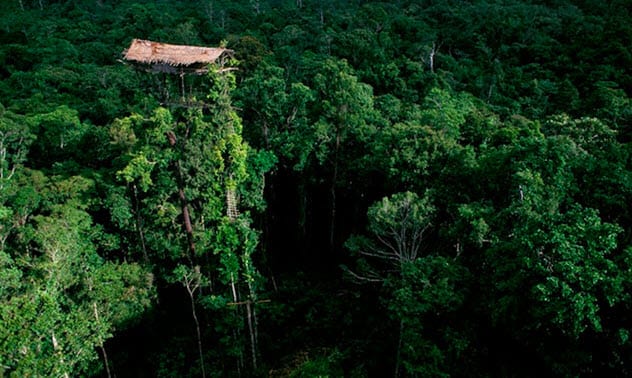
In Papua, Indonesia, there is a treetop community that existed in total isolation until missionaries intruded in the 1970s. While they reportedly don’t practice cannibalism anymore, they are notorious for being one of the last active cannibalistic tribes.
Unfortunately, the Korowai are lesser known for continuing the wondrous architectural traditions of their ancestors. They build their unique homes in the shelter of the jungle’s thick canopy.
The average height of a home is about 10 meters (33 ft) off the ground, but some are as high as 35 meters (115 ft). The Korowai construct the floors to be incredibly sturdy, so each home can hold about a dozen people. Family groups live together, along with their pets and other domestic animals like livestock.
There are many possible reasons why the Korowai live in the trees. It could be to avoid their bothersome neighbors, evil spirits, flooding, or just the hordes of malaria-carrying mosquitoes that terrorize them below.
The biggest threat to the Korowai’s treetop residences is fire. Each home has its own fire pit. To avoid having their tree houses go up in flames, they design a cutaway floor around each fire pit for emergencies.[2]
8 95-Year-Old Njuguna Ng’ang’a
For four years, Njuguna Ng’ang’a of Kenya lived his days in the shelter of a tree trunk because he had nowhere else to go. He said, “Life drove me here.”
Without identification, he was not able to receive a living stipend from the government. When asked his name or where he was from, he often gave conflicting statements. It seems that he couldn’t remember the details of his life anymore. After all, he was 95 years old.
While living inside the Eucalyptus tree, he was discovered by a young schoolboy who brought news of his whereabouts to the nearby village. The kindhearted villagers began to take care of him to the best of their ability. They brought him food, blankets, and other supplies.
On Kenya’s international holiday celebrating the elderly, the popular Kenyan entertainment channel NTV picked up Ng’ang’a’s story. They were shocked to find that the area surrounding his tree was infested with snakes. It was a miracle that he had survived without being bitten.
Two weeks later, social services was able to place him in a new home that was sponsored by the county government. Ng’ang’a said, “I don’t have many days left to live, maybe five years, and this will be my resting place when my days are over.”[3]
7 Luxurious Tree House Community
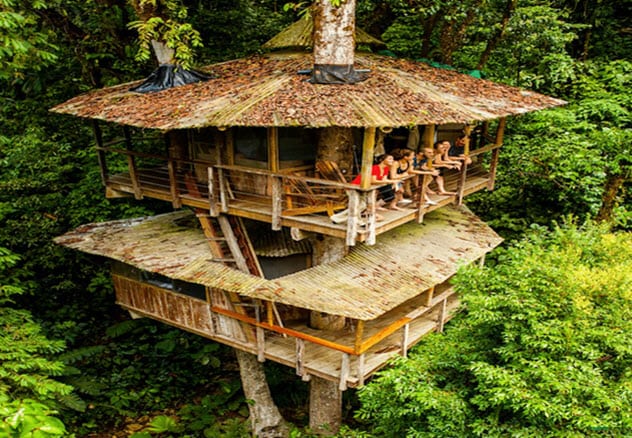
In the heart of the Costa Rican rain forest lies 600 pristine acres with 40 solar-powered tree houses. Finca Bellavista is Shangri-La suspended in the trees.
It began with Matt Hogan and Erica Andrews saving that plot of land from being harvested for its timber. From there, an eco-conscious community was born for the young at heart. Hogan sa, “You’re completely immersed in nature, you go to bed listening to the bugs and the frogs, and you wake up with birdsong.”
The homes are all built among the trees. Some exist on stilts of locally grown teak, and others use the trees as anchors. The most impressive, however, are fully arboreal homes built above the oldest trees with the deepest root systems. The on-site botanist needs to approve these, of course. El Castillo Mastate was approved, and now it stands 27 meters (90 ft) aboveground.[4]
Finca Bellavista prides itself on being “the world’s first planned, sustainable tree house development.” The tree houses are only accessible through an intricate series of zip lines, suspension bridges, and a lengthy system of hiking trails. While some may complain about the mosquitoes and the difficulties of being off the grid, others are intrigued by this rapidly growing industry of luxury tree house living.
6 Self-Reliant Nick Weston
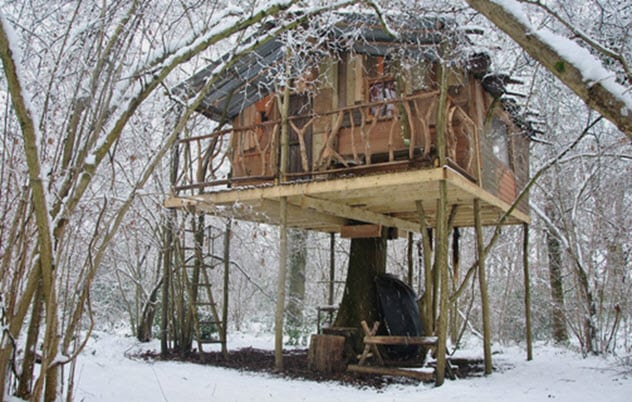
By 2050, 66 percent of the world’s population is predicted to reside in cities. For some, city life just isn’t a fulfilling way to live. Nick Weston wrote, “I took stock of my London lifestyle and decided a change was in order.”
He was fed up working at a job he despised and paying sky-high prices for food and rent. He had the wild dream of being self-reliant and living more in tandem with nature. So he began work on a project that was more closely aligned with his values.
Weston resided in the woods of Ashdown Forrest for six months. His survival depended on gathering some staple herbs and hunting rabbit, pigeon, and eel. Atop an English oak, he constructed a one-bedroom tree house complete with all-natural, recycled materials (most of which he found dumpster-diving).
He even had a wood-burning stove that he made from a 208-liter (55 gal) steel drum. Weston said, “The tree house was a symbol for rekindling the spirit of the child within, recapturing the days when there were few worries, and anything seemed possible.”[5]
Weston’s tiny tree house living may be part of a larger movement of youth that is renouncing material success and looking toward experiences for fulfillment.
5 Tree House Villages In The Forests Of Germany
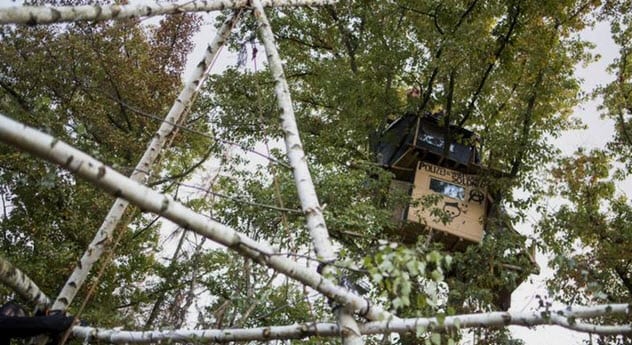
For six consecutive years, there’s been a small tree house village in the Hambach Forest near the German-Belgian border. The forest is 12,000 years old, and it’s being eradicated because of coal mining.
The forest was bought by RWE, a powerful energy company, in the late 1970s. Since then, 90 percent of the Hambach Forest has been cut down. It used to be the size of Manhattan.
Activists have been trying to fight RWE. Their protest camp consists of dozens of connected tree house villages with affectionate names like “Lazytown” and “Cozytown.” The tree houses may appear rudimentary. But they are actually very effective and provide a communal atmosphere.
Most of the tree houses run on solar electricity and even have Internet. Furthermore, they are only accessible by rope and ladder so that RWE cannot cut down the trees. They have occupied the treetops since 2012 and use the tree houses as “living barricades.”[6]
Sadly, in September 2018, the camp began to be forcibly dismantled and people were evicted from their beloved tree homes. Eviction was halted, however, when journalist Steffen Meyn fell from a suspension bridge and died. The fate of the tree-sitters and the Hambach Forest hangs precariously in the balance.
4 Lumberjack Jim Allen
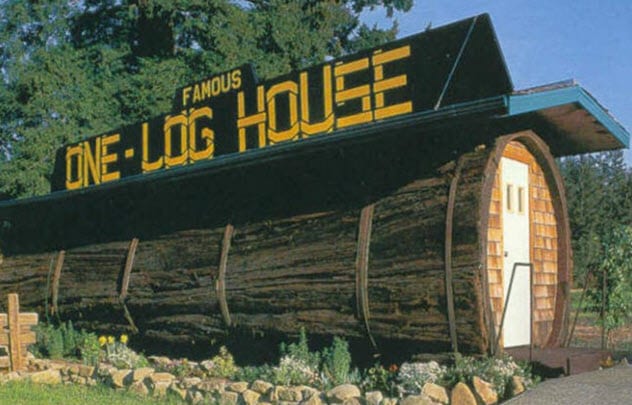
In the 1930s, Jim Allen, a lumberjack by trade, found himself alone in the redwood forest of California during a turbulent storm. He managed to take refuge by hiding in the burned-out trunk of a giant redwood.
He was overwhelmed with gratitude for the tree’s protection. He figured that no house could be as good as the genuine thing. So he purchased a fallen tree from the local lumber company and set out to carve out his home from the source.
The tree was 4 meters (14 ft) wide at the stump and 81 meters (267 ft) tall. With the help of one other man, Allen hand-carved a three-room home and lived there for seven years.
From the outside, it looks just like a felled tree. Inside, it’s as cozy as can be. They sanded down the interior walls by hand and used a clear varnish to emphasize the redwood’s natural grain. Power was even installed in the 1940s, and a fridge was added.[7]
Allen’s Original Redwood Log House is much the same as it always was. It resides along the highway as a tourist attraction in the small town of Garberville in Northern California. For a small fee, you can walk through Jim Allen’s masterpiece.
3 Barefoot Nomad Mick Dodge
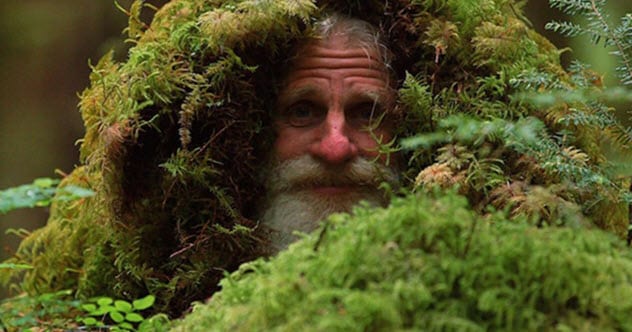
Mick Dodge has been living off the grid for almost 30 years in the Hoh Rain Forest of the Pacific Northwest. Dodge lives inside a variety of mossy tree stumps as he wanders around. He says, “There’s not a better bedroom in the world!” And he never dreams of a normal life.
He wakes up every morning and forages for his breakfast. He’s also a scavenger. So he’ll eat roadkill or an elk killed by a mountain lion, for example. A lot of his free time is spent reading. If he likes the book, he’ll plant a tree and share the book. If he doesn’t believe in its value, he’ll plant a tree anyway. But he’ll use the book as toilet paper or fire starter.
He calls himself a “barefoot nomad” because he doesn’t wear shoes. His feet are covered in intricate tattoos of a root system. He says, “My feet became my map. My feet became my compass. [ . . . ] When you step out of your shoes, your senses come more online. You’ve got over 200,000 nerves in the feet.”
Although it took a lot of convincing, he agreed to have his lifestyle filmed for National Geographic in a show called “The Legend of Mick Dodge.” When he’s asked what people will think of him after the show airs, he replies, “I have no idea and don’t give a s—t.”[8]
2 Claustrophobic Shawnee Chasser
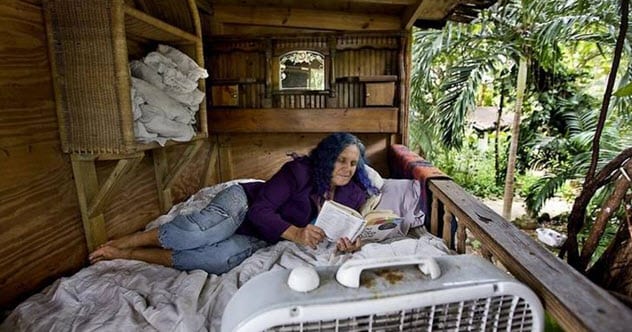
Shawnee Chasser is a purple-haired grandma with claustrophobia who adores the feeling of being mid-air. Since 1992, she had been happily living in a tree house in her own backyard. Her sanctuary in the sky was on a half-acre of wooded land. There was a man-made pond and even a waterfall.
Sadly, Miami-Dade County demanded that she demolish her home. They claimed that it was an unsafe structure (despite having survived Hurricane Andrew). South Florida is prone to hurricanes, and the building codes are rigid. Ricardo Roig of Miami-Dade’s code enforcement division said, “This has got to be my first time ever of somebody living in a tree house.”
Roig insisted that she could live in a tree house if she wanted to, but it had to be a legal tree house that was up to code. Of course, she needed to apply to the zoning department so she could get the permission to inhabit a structure on the land that is not her main home.
Chasser is in her late sixties and sells bags of organic popcorn to Whole Foods to make her living. So she couldn’t afford to hire the engineers and architects that the county required. She said, “I’m not taking down anything. I’ll chain myself to that tree house.”[9]
Although we couldn’t find confirmation of the final outcome, a 2018 YouTube video said that Chasser was being forced to demolish her tree house.
1 Early Settlers In The Wild West
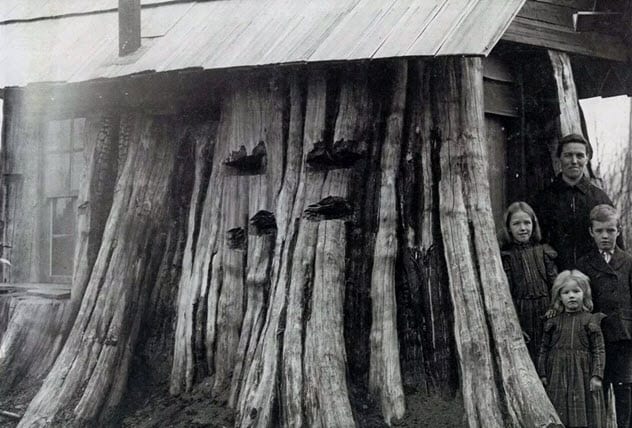
After loggers swept over the old-growth forests of the Pacific Northwest in the late 1800s, many pioneers were just coming across on wagon trains to settle down with their families. To their surprise, these early settlers discovered a mauled landscape dotted with enormous, towering tree stumps that the lumber companies had left behind.
Some of these sturdy stumps were 3 meters (10 ft) tall. These old logging sites that had cleared the forest seemed perfect for farmland. So some of the thriftiest pioneers had the wise idea to homestead these areas. They settled in what became known as “stump homes.”[10]
Basically, all the settlers had to do was put a roof on top of the stumps and attach a door. While some lived in these homes with their families, others used them for storage or chicken coops.
For some stumps that remained on the property, the pioneers came up with other creative uses. Some were leveled off at the top into flat platforms where the people would have social gatherings, like “stump dances” to folk music. One of these stump homes became the first US Post Office in the remote Olympic Peninsula, and it still stands today as a historic landmark.
Read about more people who have lived in strange places on 10 Strangest Places People Actually Lived and 10 Communities Of People Who Live Underground.








